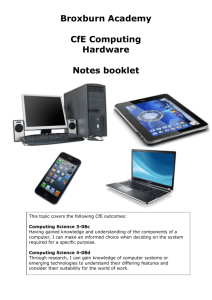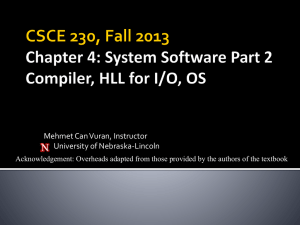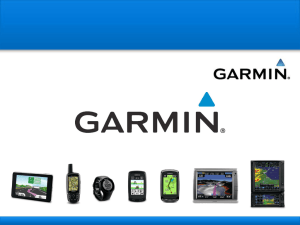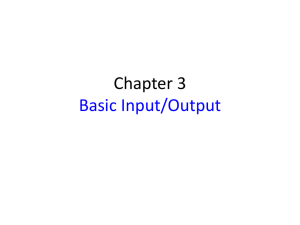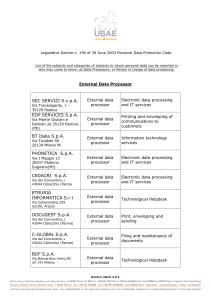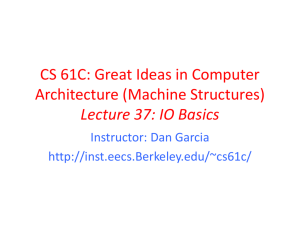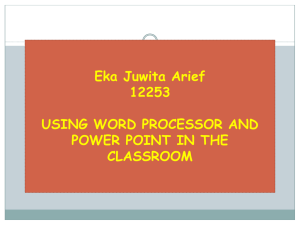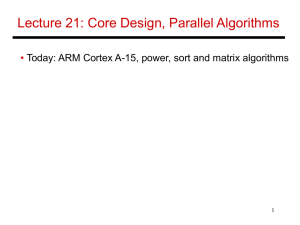Chapter 3 - part 1 - University of Nebraska–Lincoln
advertisement
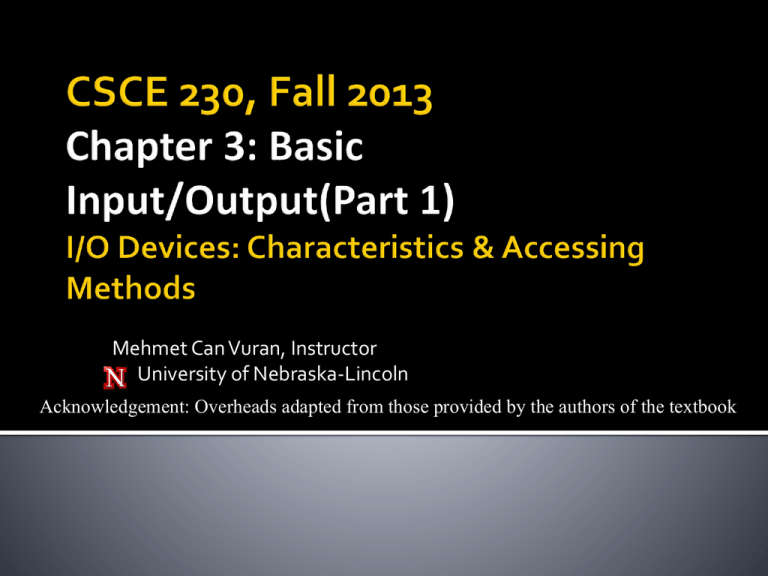
Mehmet Can Vuran, Instructor University of Nebraska-Lincoln Acknowledgement: Overheads adapted from those provided by the authors of the textbook I/O Transfers either direct to Main memory or via Processor Dedicated Bus Shared Bus aka I/O Interface Trend toward narrow pipe-width, high-BW, standard I/O interfaces (e.g. USB, Firewire, ATA, Ethernet) 2 3 Keypoints: 1. Huge data-rate range – 12 orders of magnitude 2. Higher data-rate range when machine is partner 3. Network treated as an I/O device 4 I/O is mediated by the OS Multiple programs share I/O resources ▪ Need protection and scheduling I/O events happen asynchronously relative to processor clock I/O programming requires attention to detail ▪ OS provides abstractions to programs 5 Programmed I/O (Processor involved in I/O transfers) Wait-Loop (Continuous Polling) ▪ CPU checks device status and waits if device is not ready for I/O, otherwise performs the I/O Interrupt-driven I/O ▪ CPU can selectively enable interrupts from I/O devices ▪ A ready device, with interrupts enabled, causes CPU interrupt. ▪ Interrupt service routine performs the I/O Periodic Polling ▪ Periodically check I/O status register and perform I/O if device is ready. 6 Non-Programmed I/O (Intelligent I/O interface handles transfers) Example: Direct memory access (DMA) ▪ OS provides starting address in memory ▪ I/O controller transfers to/from memory autonomously ▪ Controller interrupts on completion or error We will focus on programmed I/O 7 . . . No Device Ready? Yes In its basic form, Wait-loop I/O is not very useful because it makes a very fast processor wait on relatively slow I/O devices. Perform I/O . . . 8 Can’t predict where Program 1 will be interrupted. 9 Program 2 POLLING Routine Timer Interrupt Device Ready? No Yes Perform I/O 10 17 Registers in an I/O interface are accessible by both the device and the processor Here concerned primarily with processor access. How does the processor access them? What options are available? 18 By creating a separate logical space for I/O addresses, we can add a new class of I/O instructions to the ISA that access this space, e.g. Read #I/O-Register Write #I/O-Register 19 Overload existing ISA instructions for I/O. load and store are obvious candidates – already used by processor to communicate with memory. Hence, e.g.: Load R2, I/O-Register(R0) Store R2, I/O-Register(R0) where, R0 stores the starting address of the I/O device This scheme is called memory-mapped I/O Need to make sure that there is no real memory in the address space assigned to I/O. Hence special forms of load and store (Nios II uses loadio and storeio) must be used. 20 Echo entered characters on display Upon a key press Get the character Store it in memory Wait for display to be available Display the character Repeat until end-of-line (carriage return) is pressed 22 23 Keyboard circuit places character in KBD_DATA and sets KIN flag in KBD_STATUS Circuit clears KIN flag when KBD_DATA read Program-controlled I/O implemented with a wait loop for polling keyboard status register: READWAIT: LoadByte And Branch_if_[R4]0 LoadByte R4, KBD_STATUS R4, R4, #2 READWAIT R5, KBD_DATA 24 Display circuit sets DOUT flag in DISP_STATUS after previous character has been displayed Circuit automatically clears DOUT flag when character is moved to the display buffer, DISP_DATA. Similar wait loop for display device: WRITEWAIT: LoadByte And Branch_if_[R4]0 StoreByte R4, DISP_STATUS R4, R4, #4 WRITEWAIT R5, DISP_DATA 25 Consider a complete program that uses wait loops to read, store, and display a line of characters Each keyboard character echoed to display Program finishes when carriage return (CR) character is entered on keyboard LOC is address of first character in stored line CISC has TestBit, CompareByte instructions as well as auto-increment addressing mode 26 27 28 Study the Nios II Implementation of Fig. 3.4 on Fig. B.12 34 I/O devices vary tremendously in range, bandwidth, and response requirements OS must mediate because multiple programs may share an I/O resource and I/O programming requires a lot of attention to detail Complexity reduced by standard interfaces So far, considered only the polling method – appropriate for low bandwidth devices. 35 HW 2 – Chapter 2 Assign Monday, Sep. 16th Due Monday, Sep. 23rd Quiz 2 – Chapter 2 (2.1-2.7) Wednesday, Sep. 25th (15 min) 36


